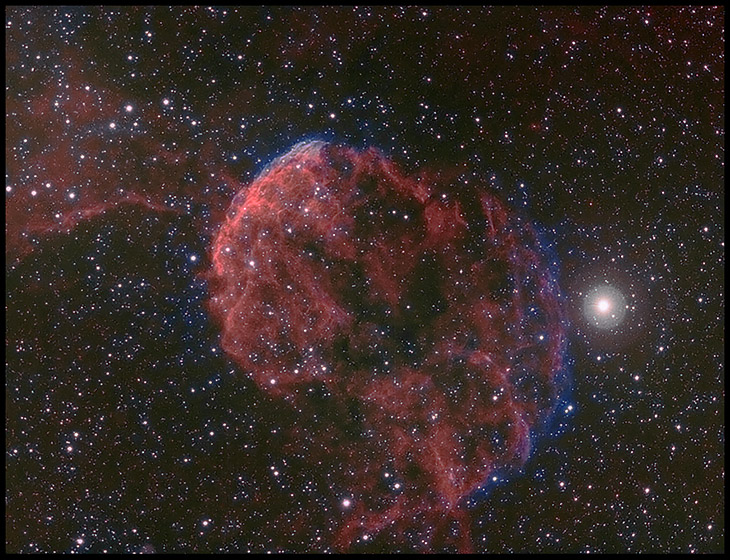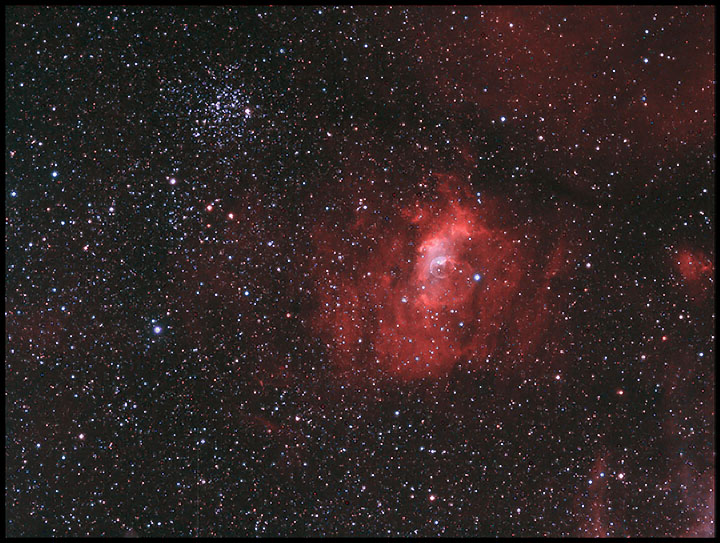11/20/2016. I shot 30- and 60-second darks and then took Ha, Oiii, and a single Sii frame (just to see what's there) of the Bubble. Then short exposures (30 and 60s) in L and R of M31 to try again for the nuclear spiral. And I left the outfit shooting IC 443 in Ha (mostly) with a few Oiii's tossed in until dawn. Orientaton 0-degrees for eveything.
IC 443 is accessible in the gap over the 19th Fairway, so I got an early start on it. It's fainter than I remembered. I put the 'scope on it at 1:30 or so and imaged into morning twilight. I got 14 good H-a images and 4 good O-iii images which after much persuasian combined into this:

IC 443
14x900s H-a, 4x900s O-iii (4h 30m)
TMB92SS, ST2000XM
I synthesized a green channel by averaging the H-a and O-iii and produced an RGB image from the three channels. What you see here is the H-a image with color from that RGB image. Here's a smaller bubble blown by a different mechanism:

M52 and the Bubble Nebula
10x900s H-a, 4x900s O-iii (3h 30m)
I expected more O-iii influrence in the Bubble's field. S-ii actually has a decent signal in that area, but I haven't used the single frame I took to decide whether it would be worth investing more time in that wavelength. I did not synthesize a green image. Not yet anyway. This one has a ways to go.
M31's nuclear spiral is still not showing itself to me. All these consecutive clear nights have me a little whoozy, so I may well be missing some tricks. The game is not over, but I am done for now.
11/21/2016. Way out in the Cygnus spiral arm, one star is passing behind another. Actually behind two. I just saw an AAVSO alert for a microlensing event, and wish I had seen it a day or two earlier. I had no idea they were into that. Anyway the "final caustic crossing" of this event should have happened last night but may not have. So I'm planning to take a sequence starting as soon as the sky will yield 14th magnitude stars and running until the field hits the trees. After that, I'll try for a supernova remnant in Taurus and Aurigae that I've only shot once before. I've rotated the camera to 180-degrees, the better to find guide stars during that imaging run later tonight.
My deep-sky photos are made with a variety of sensors and optics. Deepest images usually come from a SBIG ST2000XM CCD behind a 10-inch Astro-Tech Ritchey-Chretien carried on an Astro-Physics Mach1GTO. The CCD is equipped with a CFW-10 loaded with Baader wide- and narrow-band filters. Camera control and guiding are handled by Maxim DL 5.12. A Canon 6D and a modded 50D find themselves mounted behind an Orion 10" F4 Newtonian or a 92mm Thomas Back refractor or a tiny but mighty AT65EDQ refractor, sometimes with Backyard EOS in control and PHD Guide keeping things on target. Really widefield photos are often made using the 6D and various camera lenses and an iOptron Skytracker mount. PixInsight does most of the heavy lifting in post-processing — alignment, stacking, gradient removal, noise-reduction, transfer function modification, color calibration, and deconvolution. Photoshop along with Focus Magic and a handful of other plugins get their licks in, too, especially when polishing for the web.
:: top ::